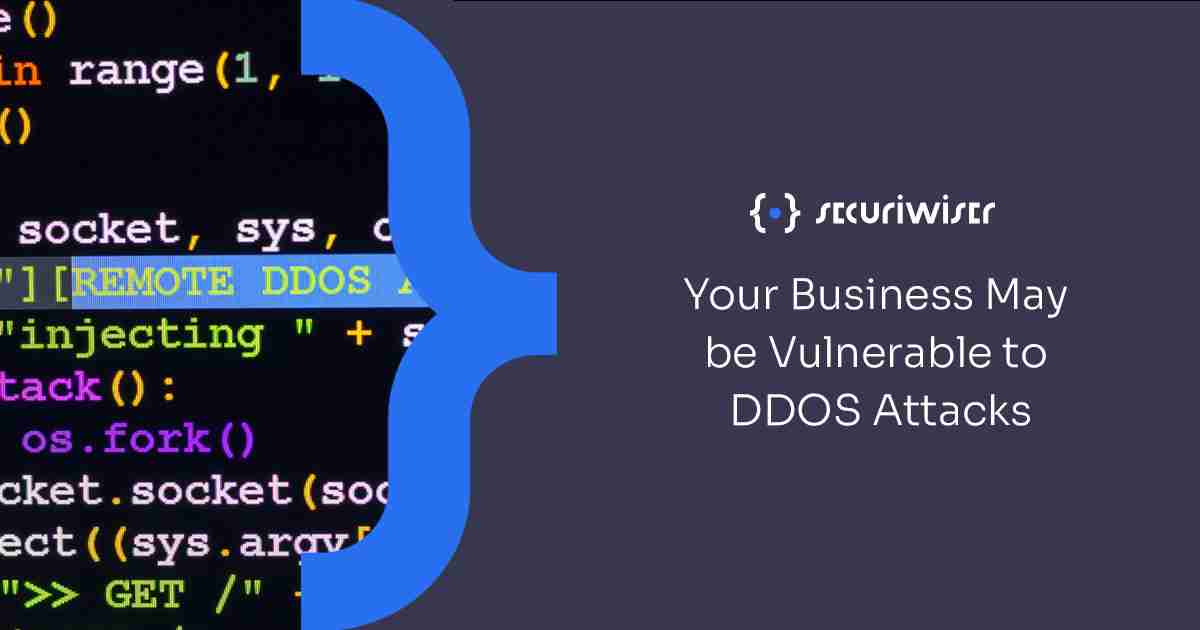Your Business May be Vulnerable to DDoS Attacks – Here’s How You Can Help
Blog / Your Business May be Vulnerable to DDoS Attacks – Here’s How You Can Help
4 MIN READ


Year after year, distributed denial of service (DDoS) attacks become more prevalent. DDoS attacks are becoming a great concern for businesses, as threat actors are becoming bolder, targeting larger corporations with denial-of-service attacks. Even internet powerhouses such as Amazon Web Services have fallen victim to DDoS attacks recently. As DDoS attacks become more sophisticated, it is important to know how to protect yourself in case it happens to you.
What is Distributed Denial of Service?
Distributed Denial of Service (DDoS) attacks are when a threat actor utilises multiple remote sources to attack online services. The remote sources usually take the form of botnets. For example, a threat actor may use many computers on a botnet to flood a network service with information, causing congestion and limiting access.
When a DDoS attack occurs, the flooding of a service makes it difficult for normal users to access the service, and may even result in the service being temporarily taken down.
Why do DDoS attacks occur?
Distributed Denial of Service attacks differ from usual cyber-attacks, as the reason for them may not be obvious. Sometimes, there may be no clear reason for why a threat actor attacks a service, and that is what makes DDoS attacks so dangerous.
DDoS attacks are generally speaking malicious or vindictive in intent. Many denial-of-service attacks occur as a form of criticism or protestation for an action a business may have made. Competing businesses or angry customers may use CaaS (Cybercrime as a Service) DDoS attacks to disrupt a business’s online services. DDoS attacks may also be used to distract an organisation from more threatening ongoing cyber-attacks.
DDoS Types – a Brief Overview
Application Layer Attacks:
Application layer attacks, sometimes called layer 7 attacks, target the top layer of the network model. The top layer is the application layer which holds the parts of a system used to allow human interaction with an online service.
Application layer attacks use a high volume of standard looking web traffic through normal channels like HTTPS or DNS. It is hard to tell if you are being targeted by an application layer DDoS attack as it may just seem like an unusually high volume of normal traffic.
Protocol Attacks:
Protocol attacks target areas of a network that verify incoming connections. Attackers will send deliberately slow pings and partial packets to cause congestion, as the server struggles to verify the incoming broken connections.
Volumetric Attacks:
Volumetric attacks flood a network’s open ports with false data requests. The flooding of false requests causes a server to prioritise verifying these false requests over legitimate traffic, meaning the server has no resources left to check legitimate requests. This means while a large volumetric attack is happening, standard users are not able to access online services.
Preventing and mitigating DDoS attacks.
DDoS attacks can occur at any time and for any reason. Attackers are also constantly making their DDoS attacks more complex, using hybrid attacks to target different areas of a network, as well as increasing the volume of information to increase effect on a business. As such it is important to know how to prevent attacks from occurring where possible, and how to mitigate the extent of an attack should one occur.
Use DDoS prevention solutions to protect your infrastructure.
Resourceful DDoS attackers will often make use of multiple avenues of attack. Because of this, it is important to make sure all the standard attack channels are protected by some form of DDoS prevention. Some protocol attacks may target firewalls, meaning a firewall alone doesn’t provide full protection against DDoS attacks.
DDoS prevention solutions combine a variety of protection measures, such as content filtering, VPNs, and firewalls. Often, network equipment will come with integrated DDoS prevention measures, however these tools do not always provide the best prevention measures possible. It may be worth investing in third-party DDoS prevention solutions on top of maintaining a strong network architecture.
Use the Cloud
Cloud-based DDoS prevention services can provide many benefits to a small-to-medium sized organisation. Primarily, cloud services mean you don’t have to rely as heavily on your own hardware. Also, cloud services will generally have a much higher bandwidth than a small business might. Using cloud-based DDoS prevention will help take care of high volumes of malicious traffic.
Build Strong Network Architecture
It is important to have strong network architecture in place to prevent DDoS attacks. Building strong architecture includes increasing network redundancy. Network redundancy is the process of adding more instances of network devices to increase network availability, and reduce impact of incoming DDoS attacks. Having data centres in multiple geographic locations can also help spread a DDoS attack thin; for a small business this is where cloud services may come in handy.
Create a DoS Response Plan
Preparing a DoS response plan can help prevent unnecessary damage to your business as a result of a DDoS attack. A standard DoS response plan will include:
- Systems Checklist – Systems and assets in place to prevent, assess, and identify an incoming DDoS attack. A systems checklist should provide an exhaustive list of all hardware and software level prevention methods.
- Response Team – Form a response team to deal with a DDoS attack. Delegate responsibility to different members for organisation purposes. Make sure response team members know who and when they should contact if a DDoS attack is detected.
- Communication Strategies – Develop a list of who to contact in case of a DDoS attack. This may include customers and security providers.
About Securiwiser
Securiwiser is a cybersecurity assessment suite. If you are concerned about your organisation’s cybersecurity profile, you can receive a free cybersecurity report from Securiwiser here. With this report, you can see areas of weakness in your cybersecurity posture, and receive information on how you can fix it.
Previous Article
The importance of patch testingHow secure is
your business?
Blog categories
How secure is
your business?